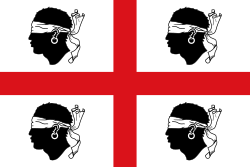Difference between revisions of "Language/Campidanese-sardinian/Pronunciation/Alphabet-and-Pronunciation"
m (Quick edit) |
|||
| Line 1: | Line 1: | ||
[[File:sardinian-flag-polyglotclub.png|thumb]] | [[File:sardinian-flag-polyglotclub.png|thumb]] | ||
Sardinian (sardu) is a Romance language with about 1.2 million speakers in Sardinia. There are four dialects of Sardinian: Logudorese (Logudorian), [[Language/Campidanese-sardinian|Campidanese-sardinian]] (Campidanian), Gallurese (Gallurian), and Sassarese (Sassarian). | |||
Campidanese is written using the Latin alphabet. Like Italian, Campidanese does not use w and y. Campidanese also uses the digraphs gh, representing /g/, ch representing /k/ before the vowels e and i, tz representing /ts/, and x, representing /ʒ/. | |||
Campidanese is written using the Latin alphabet. Like Italian, Campidanese does not use w and y. Campidanese also uses the digraphs gh, representing /g/, ch representing /k/ before the vowels e and i, tz representing /ts/ and x, representing /ʒ/ | |||
In phonetic syntax, the final or intervocalic t is pronounced like a /d/ and s is pronounced like a /z̪/. When there are consonants like s, t, or nt at the end of the word, an auxiliary vowel is usually added. If preceded by a consonant, an "i" is inserted before the normally initial s. After mastering the Campidanese-sardinian pronunciation, you can explore other related dialects and lessons to enhance your understanding of this beautiful language. | |||
__TOC__ | __TOC__ | ||
==Alphabet== | ==Alphabet== | ||
| Line 130: | Line 126: | ||
[[Category:Alphabet-and-Pronunciation]] | [[Category:Alphabet-and-Pronunciation]] | ||
<span links></span> | |||
Latest revision as of 21:35, 25 March 2023
Sardinian (sardu) is a Romance language with about 1.2 million speakers in Sardinia. There are four dialects of Sardinian: Logudorese (Logudorian), Campidanese-sardinian (Campidanian), Gallurese (Gallurian), and Sassarese (Sassarian).
Campidanese is written using the Latin alphabet. Like Italian, Campidanese does not use w and y. Campidanese also uses the digraphs gh, representing /g/, ch representing /k/ before the vowels e and i, tz representing /ts/, and x, representing /ʒ/.
In phonetic syntax, the final or intervocalic t is pronounced like a /d/ and s is pronounced like a /z̪/. When there are consonants like s, t, or nt at the end of the word, an auxiliary vowel is usually added. If preceded by a consonant, an "i" is inserted before the normally initial s. After mastering the Campidanese-sardinian pronunciation, you can explore other related dialects and lessons to enhance your understanding of this beautiful language.
Alphabet[edit | edit source]
| Letter | Name | IPA |
|---|---|---|
| A a | a | a |
| B b | bi | b, β |
| C c | ci | k, tʃ |
| D d | di | d, ð |
| E e | e | e |
| F f | efa, effa | f |
| G g | gei | g, dʒ, ɣ |
| H h | àca, aca | |
| I i | i | |
| J j | ai long, jota | vj |
| K k | capa | k |
| L l | ella | l |
| M m | emma | m |
| N n | enna | n |
| O o | o | o |
| P p | pi | p |
| R r | erra | ɾ |
| S s | essa | s, z |
| T t | ti | t |
| Tz tz | zeta surda | ts |
| U u | u | |
| V v | vu | v |
| X x | ìchisi | ʒ |
| Y y | ipsilon | |
| Z z | zeta sonora | dz |
Videos[edit | edit source]
How does Sardinian Campidanese sound?[edit | edit source]
Lior Markus speaking Occidental Campidanese Sardinian[edit | edit source]
